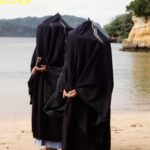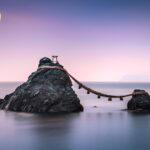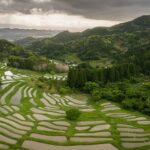OVERVIEW: As requested, I’ve tried my best to center this itinerary completely around beautiful places, and aspects of Japanese culture for you to photograph. Even the “breaks” in the itinerary are days that are used to photograph places that less intense, and allow you to somewhat relax while photographing the surroundings. When compiling subjects, I ended up categorizing each subject into the categories that you can find below the picture gallery:
Laurent Nilles
This itinerary is completely focused on photography-related sites, and experiences
Kanto region: 09/30 - 10/08
The Kanto region is the region where Tokyo is situated. For all of the regions you'll visit (where possible), rather than going from place to place, I would like to put you in the largest hub, and have you do day trips to the majority of places in that region.
The experiences for this region are listed below, and the photograph associated with them is in parenthesis at the end of it. The matsuri event for this region is actually not in this region at all, and so it would require a short flight to the Shikoku region, if you elected to go to it. Here is a video of the event, and a very brief history:
I personally think that the trip is worth it. Please keep in mind that for each of these special events, it is my intention to contact the local government to arrange a press pass for you to photograph the event, but also get the chance to photograph the participants privately outside of the event. It takes place, usually around the 3rd of October. If you elected to do all of the events on this list, it would be a very busy period. Essentially every day, you would be actively shooting as it the places in this leg of the trip are quite spread out. It is also possible to arrange for some of them to happen later on in the trip to space things out a bit more.
Activities/Experiences :
Hokkaido day trip to photograph Ainu cultural events (1)- Tsuruoka trip to photograph the Yamabushi mountain ascetics (3)
- Ama Pearl divers (10)
- Wedded Rocks of Ise (30) - another classic, but beautiful site in Japan
- Mt. Fuji + Chureito pagoda (12, and 13)
Nagano onsen + bathing monkeys (14, and 15 - low priority)- Hachiawase Matsuri (20 - see video above)
- Aogashima visit (27)
- Oyama Rice Terrace (34)
- Sumo Stable visit (currently not pictured in the gallery)
Paantu Punaha (20 - this one would be extremely difficult to do while also doing the Hachiawase matsuri event, so it would have to be one or the other, unfortunately)
Planner's Notes:
Chubu/Kitakyshu region - 10/08 - 10/13
There are a lot of naturally beautiful places in this leg of the trip, but there are also a lot of chances for capturing people in special ceremonies as well. I put the the Furyu performance in bold, because I honestly think that this could render the best photographs of the entire trip (!). It's such a unique and striking, yet relatively unknown event. As far as the performance itself goes, please do not expect too much as it is a very rural location. It is visually stunning, yet understated.
Activities/Experiences :
- Kannushi portraits (4) - The preference for this shoot is currently Takachiho, and would happen when visiting there (also see photo #31)
Taketomi Island - currently a tentative addition, so no photos yet- Furyu performance (23) - The performance takes place in Saga prefecture, and is a very long tradition for that area - Of all of the Furyu performances, I do think that the Tentsukumai will be the most striking, and I've written about it in the description section below the gallery.
Iriomote Island in Okinawa (26) - I think that this would be one of the best places to witness some true Ryuku (Okinawan) culture. I've included a picture of the mangroves, but also some people in garb for a ceremony on the island as well to give you an idea of what would be possible there.Yakushima Island (28) - The ancient forest on this island has trees that are thousands of years old. This is the location that inspired some of Hayao Miyaziki's works - It is beautiful, but it is a very nature-centered stop, thus it depends on your priority for nature shotsBeppu 7 'Hells' (29) - This is the 2nd largest hot springs location on Earth, and there are pools of water here that are very beautiful that could make another good nature shot location - low priority as the spots are quite touristy- Takachiho Gorge (31)
- Akiyoshido Cave (32)
- Motonosumi Shrine (33)
Planner's Notes:
Kansai region: 10/13 - 10/23
This leg of the trip is definitely more focused on people, their work and their culture. I think that this leg is the part of the trip that most requires a good assistant, as you would be speaking with a lot of people during the shoots. This section also has some of the more unique experiences in it that I'm most looking forward to getting your feedback on. For instance, the ink-makers in Nara. A lot of ink-makers still use very old and traditional methods, and it is a very interesting visual story. I've described it a bit in the section below the gallery, however this video on the topic is quite excellent (and also gives you a very good visual):
Some of the other very visually striking and interesting experiences that I would like to arrange for this leg are the cormorant fisherman in Gifu, and also the tattooed mafia members. As I'm sure you are aware, Japanese tattoo traditions have exploded in popularity globally, however their meaning and significance are still not very well known. They are beautiful though, and I think it would make for a good portrait if you are interested in that side of Japanese culture.
Activities/Experiences :
- Mafia members' tattoos (2)
- Buddhist monks at a temple (6) - I think using the temple as a backdrop would make for an excellent photo - we have connections with many temples and thus could provide you with several different options if we were to do this in this region
- Katana swordsmith (7) - I think that this would make an absolutely amazing photograph if we were to arrange this at a forge
- Calligraphy ink makers (8) - see the video above
- Geisha, Geiko or maiko (9) - we can arrange for a shoot with them
- Noh theater actor (11) - preferably in performance garb, however it would be nice either way - we would ask the actor to bring multiple masks with them for the shoot
- Nachi Falls in Koyasan (16)
- A day to visit some of the traditional sites of Kyoto (17), (18) - This would be a day where you can visit some of the classic "highlights" in Kyoto like Fushimi Inari (18), or Sanjusangendo (19) - other locations can also easily be arranged
Karatsu Kunchi Matsuri event (21) - beautiful matsuri event that is a great photo op- Japanese bull sumo (24)
- Ukai cormorant fisherman (25) - I personally think that this one could also be a highlight
Planner's Notes: #30 (the Wedded Rocks of Ise), would actually probably make more sense to shoot on the same day that you shoot the Ama pearl divers (#10) as it is in the same region. Please note that I've prioritized sites that are interesting visually and culturally, over touristy spots for all regions, but especially for this region as it has a lot of touristy locations. I do, however, realize that the "classic" sites may be important for you to photograph and so I have included a few of them, like Fushimi Inari, in this iteration of the itinerary. It will be very crowded though at these location, which means getting a good picture may be difficult at certain times of the day. We like to arrange visits to these places late in the evening as the sun is going down to minimize the number of people in the photos.
All of the photographs in this gallery are numbered from 1-34 (yellow number in the top left corner). Please refer to the itinerary map to see which photo correlates to which region. The finer more specific details on some of the events are in the description sections below the gallery.
People
This category will contain everyday people in Japan that represent or symbolize the country in some way. I imagined this category to contain “normal” people, however those who may or may not be easily recognizable as “Japanese” through their clothing, outer appearance or some other signifying element. Currently in this category I have the following subjects for your consideration:
- Ainu people in Hokkaido – Often overlooked or forgotten, but the native Ainu people in Hokkaido are just as much a part of Japan as the Yamato people in Honshu. If you are looking for a “complete” look at Japan and its people, then including some work with the Ainu may be advantageous.
- Yamabushi – The yamabushi are the men and women of myth that are mountain ascetics in certain regions in Japan. Not only is their lifestyle quite unique, but the yamabushi people that live in the Yamagata area are surrounded by beautiful surroundings, making the nature and shrines an excellent “backdrop” for your photography.
- Buddhist monks / Shrine maidens or kannushi – Shintoism and Buddhism have played a massive part in shaping Japan’s culture. Including a photo shoot with monks or shrine attendants may be a good subject to include.
- Mafia members – I think that seeing someone who is covered in tattoos from head to toe with beautifully, and meticulously designed elements is something that we nowadays immediately associate with some of Japan’s seedier elements. However this culture and art is still nonetheless very “Japan”.
- In addition to these, there are a few other smaller shoots that I think would be good to plan that I will mention in the map section of this page.
For all of the days in this section, we would like to arrange a photo shoot with the subjects well in advance.
Craftsmen
The next category is related to the former, but I think that this category is more specific. It is the “craftsmen” category. Another category that I think Japan is known for as its excellent craftsmen have given the country a reputation of excellence in so many different fields. These categories are mostly focused on people who are working in traditional arts or fields, using methods that have been practiced in Japan for a very long time.
- Swordsmith – There are currently two options for this particular shoot. One in the Kyoto area, and one in the Gifu area. I can ask both workshops to send pictures of their workshops if you are interested in photographing these craftsmen at their forge for added context.
- Calligraphy ink makers – This one isn’t really as well known, but some of the “boutique” ink makers in Japan have preserved their craft for a very long time. Those who collect soot the old fashioned way can sell their ink blocks for thousands of dollars. The storehouses where they collect their soot is strangely picturesque and beautiful. I’ve included a link to a video about this craft on the map section.
- Geisha/Geiko/Maiko – Nothing needs to be said about these artisans. They are almost like walking symbols of Japan. I would want to arrange a visit to one of Kyoto’s teahouses for this photo shoot with the explicit permission from the house’s mother.
- Ama Pearl Divers – These are very famous lady pearl divers that work in the Ise Peninsula area. I think that this could be another opportunity for a rare look at a job that is less known.
- Noh theater actor – Noh theater is deeply entangled with Japan’s spiritual beliefs. The masks that the actors wear, their movements on stage, can all be tied to a specific type of spirit that they are trying to “summon” when they are on stage through their acting. I highly think that arranging a shoot with a Noh actor is something that would be rewarding. I have a friend of a friend who is a Noh actor, as his father was, and his father’s father, and so on going for many generations. I think that he would be the perfect candidate for this as he is extremely passionate about the art.
- Ukai Cormorant fisherman – This is quite possibly one of the most visually stunning possibilities on the whole list. There are fisherman that use cormorant birds in Japan to catch fish at nighttime. They used to be under the employ of the Imperial family in Japan, and thus have maintained their traditional methods for hundreds of years. At night the boat and the river is lit only by a giant fire that is kept at the head of the boat. It is a beautiful tradition.
These would also require a private booking in advance, which wouldn’t be a problem at all.
Matsuri Events
These events are the once-a-year events that I think would provide a bit more context into Japan’s spiritual world. I distinctly remember you mentioning Charles Freger’s “Yokainoshima” body of work that he took between 2013-2015. That body of work is amazing! Please be aware that the items in this category are not an attempt on my part to imitate Mr. Freger’s stellar look into this world, but rather to place you in front of people that I know would very much like to share their cultural heritage with you as someone coming from across the world to memorialize it. With these items, I envisioned the shoot being two part. First, it would be nice to arrange a private shoot before the event where you can get the participants in their traditional, and or ceremonial garb. The second part would be photographing the matsuri event itself. For this part, I would like to ask the municipal government, or whatever body that organizes the events for a special press pass for you so that you can be up front with the people conducting the ceremonies, or those who play a central part in the matsuri (this is to avoid be trapped in the throngs of people that show up to these matsuri events).
- Hachiawase Matsuri – This isn’t a very big matsuri event, and there are very few people that know about it. There is a matsuri event in Himeji that is similar to this one called Nada Matsuri, but this one is much more violent. There are matsuri events all across Japan that involve “fighting”, where the people will gather with the mikoshi shrine of their particular area, and then ram them into the shrines of other people. These are typically very gentle “clashes” though. People are very careful not to injure others during the event. This particular matsuri however removes all barriers and limitations. It can get very violent at times, but in a way that I think is quite cathartic. If you are familiar with the fighting festivals in some areas of Central and South America (like in the Nahua Native American tribal areas, or the Takanakuy in Peru), a lot of times the festival is a way to release frustrations that have built up over the year. This is a side of Japan that outsiders rarely see.
- Karatsu Kunchi – This is a special matsuri held in Karatsu, which is in Kyushu. This matsuri is known for the outlandish and beautiful floats that are paraded through the streets. Please refer to the video in the itinerary for a visual reference.
- Furyu – I think that this is one of the more unique offerings in this category. These dance performances happen all throughout September and October as a way to give thanks to the gods for a successful harvest. There are multiple different dances that take place in various locations all around the prefecture. I’ve included a picture in the gallery of the one that I think you would find most visually interesting. It is called “Tentsukumai”, which roughly translates to the “heaven reaching dance”. The performer will don a really massive crescent shaped crown, which is really quite striking.
- Paantu Punaha – This is one that takes place in Okinawa. It is a ritual where men cover themselves in mud to become what is known locally as Paantu. Then they go around the village to place mud on villager’s faces and body as a sign of good luck. Mr. Freger has shot this one.
- Tsunauchi – This is a very small matsuri event that has been designated as an intangible cultural asset of Japan. It takes place in a small village off of the coast of Nagasaki. It is a very interesting event as it involves so many different ceremonies and characters, even a tengu makes an appearance. The men who are wearing large straw hats to cover their faces, will run around the village with large buckets of sand. They will then go around throwing the sand very forcefully at people in the crowds, and again, it is seen as good luck to have the sand hit you during the ceremony. I think that this one would be high up on the list in terms of charm. It really is a very small and local event, but with a very rich cultural and spiritual significance.
These are the matsuri events that I think would make good subjects during your time here. I’m mostly partial towards the Furyu events (especially the Tentsukumai one), and the Tsunauchi event in Goto. These will render authentic countryside Japanese experiences for you to capture. I have other matsuri that I have omitted from this list due to their location being a bit too remote for reaching, however if the ones on this list do not strike you as interesting please let me know and I can make a couple more suggestions. The itinerary is currently planned around the dates of the aforementioned matsuri events.
Exceptional Views
This category has two different types of items within it. The first are places that are naturally beautiful. Shrines that are located in beautiful areas, stunning landscapes, etc. The second are traditional/cultural heritage spots that are kind of like the “classic” views of Japan. I want to “sprinkle” these locations and spots in between the shoots for the other categories so that you aren’t shooting people everyday, back-to-back. I’ve organized these items by the regions that you’ll be shooting other experiences/items in so that you don’t have to go too far out to shoot these. As the pictures themselves can describe the beauty of these locations far better than I ever could, please refer to pictures in the gallery for a reference to each of them. I will attach a number to each item in the itinerary itself, and then attach the same number to the photo for ease of understanding.
These are all of the main categories. I do have one more category for “normal” events that I would also like to include, however currently there is only one event that I’ve wanted to put in it, Japanese bull sumo. It is a tradition that is slowly dying across the country, with only a few stadiums left. The art is not violent like bull-fighting in Spain, but rather is a kind of bull “wrestling” where the bulls lock horns and then push the other bull away until they give up. No bulls are actually harmed. I thought that it may also make a good subject. The trainers photographed with their bulls, that is. I will include a video explanation of the tradition in the itinerary.
As I’ve said over the last year or so we’ve been in touch (!), I’m very excited to put this together. Photography is a passion of mine, and Japan is also my passion and so bringing these two together is perfect for me. I’m looking forward to hearing your thoughts.
Client:
Keiko Suda
Start date:
September 30th, 2024
End date:
October 23rd, 2024
Arrival flight:
-
Departure flight:
-
Number of days:
~ 36 days
Season:
Autumn
Locations:
Tokyo / Kyoto / Koyasan / Okinawa / Ise Peninsula / Karatsu / Osaka / Yamaguchi
Accommodation Suggestion: Kanto area
Accommodation Suggestion: Kansai area
Accommodation Suggestion: Kitakyushu area
Guided:
Most, if not all days will have a guide/interpreter. Other days will include a guide/interpreter + a local expert. Exact days TBD.
Price:
-
Weather/Climate Conditions:
Temperatures should be around 18°C (around 64ish°F) for most of the locations you visit. Bringing warm clothes is advised. It can get pretty rainy at times as well, so please bring raincoats. Having waterproof covers for backpacks will definitely come in handy. The Takayama area will be the coldest stop.
Planner's Notes:
For the hotels and accommodations, as you mentioned on the phone that you wanted to really focus mostly, if not solely on photography, I would rather not waste money on high-end hotels, so instead I've opted for mid-range accommodations that are clean, and also located centrally so that we can take advantage of train hubs to get you to more remote destinations easier. Please note that I cannot complete an exact day-by-day for this itinerary yet as some dates for matsuri events are still not confirmed, however they should happen within the date ranges that they have been placed in for each region. Also, a lot will depend on the availability of people that you will be photographing (like the geisha/maiko, for instance). Once you've confirmed which experiences you'd like to keep we will start to ask around about availability. Due to the timing of matsuri events that are currently in the itinerary, there will be a little bit of hopping around between regions, however it isn't anything that is too extreme.









































